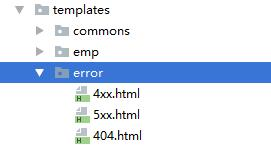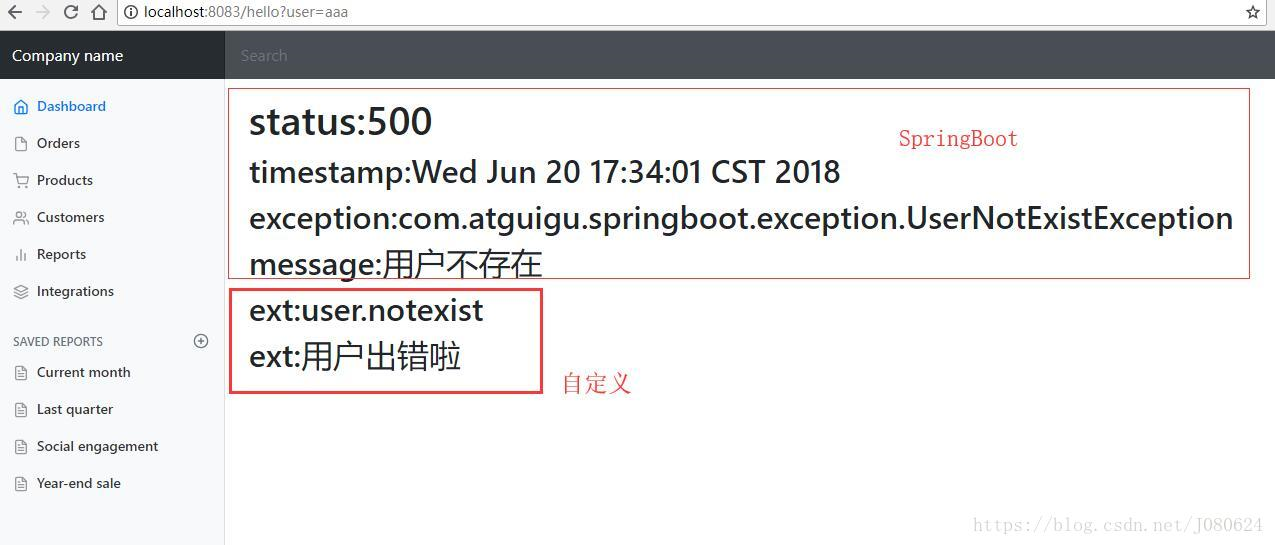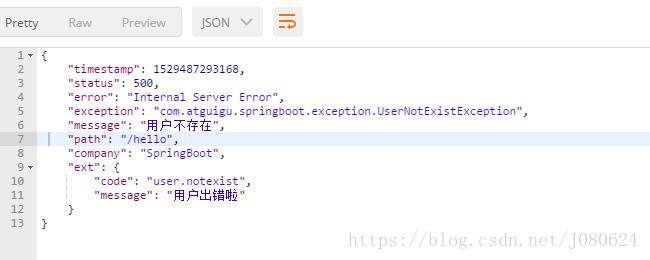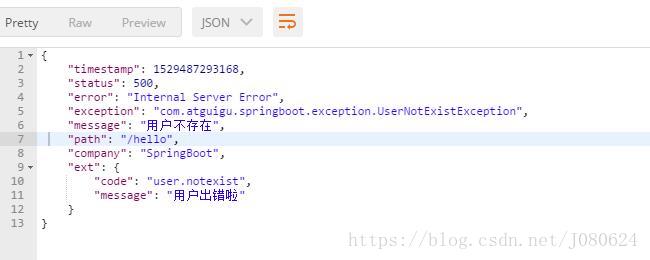Spring Boot错误处理机制与自定义错误处理实现详解
【1】SpringBoot的默认错误处理
① 浏览器访问

请求头如下:

② 使用“PostMan”访问
{ "timestamp": 1529479254647, "status": 404, "error": "Not Found", "message": "No message available", "path": "/aaa1" }
请求头如下:

总结:如果是浏览器访问,则SpringBoot默认返回错误页面;如果是其他客户端访问,则默认返回JSON数据。
【2】默认错误处理原理
SpringBoot默认配置了许多xxxAutoConfiguration,这里我们找ErrorMvcAutoConfiguration。
其注册部分组件如下:
① DefaultErrorAttributes
@Bean @ConditionalOnMissingBean(value = ErrorAttributes.class, search = SearchStrategy.CURRENT) public DefaultErrorAttributes errorAttributes() { return new DefaultErrorAttributes(); }
跟踪其源码如下:
public class DefaultErrorAttributes implements ErrorAttributes, HandlerExceptionResolver, Ordered { private static final String ERROR_ATTRIBUTE = DefaultErrorAttributes.class.getName() + ".ERROR"; @Override public int getOrder() { return Ordered.HIGHEST_PRECEDENCE; } @Override public ModelAndView resolveException(HttpServletRequest request, HttpServletResponse response, Object handler, Exception ex) { storeErrorAttributes(request, ex); return null; } private void storeErrorAttributes(HttpServletRequest request, Exception ex) { request.setAttribute(ERROR_ATTRIBUTE, ex); } @Override public Map<String, Object> getErrorAttributes(RequestAttributes requestAttributes, boolean includeStackTrace) { Map<String, Object> errorAttributes = new LinkedHashMap<String, Object>(); errorAttributes.put("timestamp", new Date()); addStatus(errorAttributes, requestAttributes); addErrorDetails(errorAttributes, requestAttributes, includeStackTrace); addPath(errorAttributes, requestAttributes); return errorAttributes; } private void addStatus(Map<String, Object> errorAttributes, RequestAttributes requestAttributes) { Integer status = getAttribute(requestAttributes, "javax.servlet.error.status_code"); if (status == null) { errorAttributes.put("status", 999); errorAttributes.put("error", "None"); return; } errorAttributes.put("status", status); try { errorAttributes.put("error", HttpStatus.valueOf(status).getReasonPhrase()); } catch (Exception ex) { // Unable to obtain a reason errorAttributes.put("error", "Http Status " + status); } } private void addErrorDetails(Map<String, Object> errorAttributes, RequestAttributes requestAttributes, boolean includeStackTrace) { Throwable error = getError(requestAttributes); if (error != null) { while (error instanceof ServletException && error.getCause() != null) { error = ((ServletException) error).getCause(); } errorAttributes.put("exception", error.getClass().getName()); addErrorMessage(errorAttributes, error); if (includeStackTrace) { addStackTrace(errorAttributes, error); } } Object message = getAttribute(requestAttributes, "javax.servlet.error.message"); if ((!StringUtils.isEmpty(message) || errorAttributes.get("message") == null) && !(error instanceof BindingResult)) { errorAttributes.put("message", StringUtils.isEmpty(message) ? "No message available" : message); } } private void addErrorMessage(Map<String, Object> errorAttributes, Throwable error) { BindingResult result = extractBindingResult(error); if (result == null) { errorAttributes.put("message", error.getMessage()); return; } if (result.getErrorCount() > 0) { errorAttributes.put("errors", result.getAllErrors()); errorAttributes.put("message", "Validation failed for object='" + result.getObjectName() + "'. Error count: " + result.getErrorCount()); } else { errorAttributes.put("message", "No errors"); } } private BindingResult extractBindingResult(Throwable error) { if (error instanceof BindingResult) { return (BindingResult) error; } if (error instanceof MethodArgumentNotValidException) { return ((MethodArgumentNotValidException) error).getBindingResult(); } return null; } private void addStackTrace(Map<String, Object> errorAttributes, Throwable error) { StringWriter stackTrace = new StringWriter(); error.printStackTrace(new PrintWriter(stackTrace)); stackTrace.flush(); errorAttributes.put("trace", stackTrace.toString()); } private void addPath(Map<String, Object> errorAttributes, RequestAttributes requestAttributes) { String path = getAttribute(requestAttributes, "javax.servlet.error.request_uri"); if (path != null) { errorAttributes.put("path", path); } } @Override public Throwable getError(RequestAttributes requestAttributes) { Throwable exception = getAttribute(requestAttributes, ERROR_ATTRIBUTE); if (exception == null) { exception = getAttribute(requestAttributes, "javax.servlet.error.exception"); } return exception; } @SuppressWarnings("unchecked") private <T> T getAttribute(RequestAttributes requestAttributes, String name) { return (T) requestAttributes.getAttribute(name, RequestAttributes.SCOPE_REQUEST); } }
即,填充错误数据!
② BasicErrorController
@Bean @ConditionalOnMissingBean(value = ErrorController.class, search = SearchStrategy.CURRENT) public BasicErrorController basicErrorController(ErrorAttributes errorAttributes) { return new BasicErrorController(errorAttributes, this.serverProperties.getError(), this.errorViewResolvers); }
跟踪其源码:
@Controller @RequestMapping("${server.error.path:${error.path:/error}}") public class BasicErrorController extends AbstractErrorController { //产生html类型的数据;浏览器发送的请求来到这个方法处理 @RequestMapping(produces = "text/html") public ModelAndView errorHtml(HttpServletRequest request, HttpServletResponse response) { HttpStatus status = getStatus(request); Map<String, Object> model = Collections.unmodifiableMap(getErrorAttributes( request, isIncludeStackTrace(request, MediaType.TEXT_HTML))); response.setStatus(status.value()); //去哪个页面作为错误页面;包含页面地址和页面内容 ModelAndView modelAndView = resolveErrorView(request, response, status, model); return (modelAndView == null ? new ModelAndView("error", model) : modelAndView); } //产生json数据,其他客户端来到这个方法处理; @RequestMapping @ResponseBody public ResponseEntity<Map<String, Object>> error(HttpServletRequest request) { Map<String, Object> body = getErrorAttributes(request, isIncludeStackTrace(request, MediaType.ALL)); HttpStatus status = getStatus(request); return new ResponseEntity<Map<String, Object>>(body, status); } //... }
其中 resolveErrorView(request, response, status, model);方法跟踪如下:
public abstract class AbstractErrorController implements ErrorController { protected ModelAndView resolveErrorView(HttpServletRequest request, HttpServletResponse response, HttpStatus status, Map<String, Object> model) { //拿到所有的错误视图解析器 for (ErrorViewResolver resolver : this.errorViewResolvers) { ModelAndView modelAndView = resolver.resolveErrorView(request, status, model); if (modelAndView != null) { return modelAndView; } } return null; } //... }
③ ErrorPageCustomizer
@Bean public ErrorPageCustomizer errorPageCustomizer() { return new ErrorPageCustomizer(this.serverProperties); }
跟踪其源码:
@Override public void registerErrorPages(ErrorPageRegistry errorPageRegistry) { ErrorPage errorPage = new ErrorPage(this.properties.getServletPrefix() + this.properties.getError().getPath()); errorPageRegistry.addErrorPages(errorPage); } //getPath()->go on /** * Path of the error controller. */ @Value("${error.path:/error}") private String path = "/error";
即,系统出现错误以后来到error请求进行处理(web.xml注册的错误页面规则)。
④ DefaultErrorViewResolver
@Bean @ConditionalOnBean(DispatcherServlet.class) @ConditionalOnMissingBean public DefaultErrorViewResolver conventionErrorViewResolver() { return new DefaultErrorViewResolver(this.applicationContext, this.resourceProperties); }
跟踪其源码:
public class DefaultErrorViewResolver implements ErrorViewResolver, Ordered { private static final Map<Series, String> SERIES_VIEWS; //错误状态码 static { Map<Series, String> views = new HashMap<Series, String>(); views.put(Series.CLIENT_ERROR, "4xx"); views.put(Series.SERVER_ERROR, "5xx"); SERIES_VIEWS = Collections.unmodifiableMap(views); } //... @Override public ModelAndView resolveErrorView(HttpServletRequest request, HttpStatus status, Map<String, Object> model) { // 这里如果没有拿到精确状态码(如404)的视图,则尝试拿4XX(或5XX)的视图 ModelAndView modelAndView = resolve(String.valueOf(status), model); if (modelAndView == null && SERIES_VIEWS.containsKey(status.series())) { modelAndView = resolve(SERIES_VIEWS.get(status.series()), model); } return modelAndView; } private ModelAndView resolve(String viewName, Map<String, Object> model) { //默认SpringBoot可以去找到一个页面? error/404||error/4xx String errorViewName = "error/" + viewName; //模板引擎可以解析这个页面地址就用模板引擎解析 TemplateAvailabilityProvider provider = this.templateAvailabilityProviders .getProvider(errorViewName, this.applicationContext); if (provider != null) { //模板引擎可用的情况下返回到errorViewName指定的视图地址 return new ModelAndView(errorViewName, model); } //模板引擎不可用,就在静态资源文件夹下找errorViewName对应的页面 error/404.html return resolveResource(errorViewName, model); } private ModelAndView resolveResource(String viewName, Map<String, Object> model) { //从静态资源文件夹下面找错误页面 for (String location : this.resourceProperties.getStaticLocations()) { try { Resource resource = this.applicationContext.getResource(location); resource = resource.createRelative(viewName + ".html"); if (resource.exists()) { return new ModelAndView(new HtmlResourceView(resource), model); } } catch (Exception ex) { } } return null; }
总结如下:
一但系统出现4xx或者5xx之类的错误,ErrorPageCustomizer就会生效(定制错误的响应规则),就会来到/status/error/4xx.html或者/status/error/5xx.html请求,也就静态页面,然后被BasicErrorController处理返回ModelAndView或者JSON。
系统默认搜索错误页面包含以下路径:
classpath:/META-INF/resources
classpath:/resources
classpath:/static
classpath:/public
也可以自定义默认页面的搜索路径:
如果以.yml为后缀访问静态资源文件的处理方法
resources: static-locations:["/templates/","/static/"]
如果是application.properties 则解决方法是
spring.mvc.static-path-pattern=/static/**
最后一种处理方法是在spring boot启动程序的类上添加@EnableWebMvc注解,它是完全按照spring mvc的方式在接管spring boot运行程序。表示启动spring mvc特性,也就是说可以通过这个注解,然后在java代码代码中实现对js或css的页面的过滤/拦截。
【3】定制错误响应
① 定制错误响应页面
1)有模板引擎的情况下,也就动态页面,页面文件里面可以显示从后台传过来的值
error/状态码–将错误页面命名为 错误状态码.html 放在模板引擎文件夹里面的error文件夹下,发生此状态码的错误就会来到 对应的页面。
我们可以使用4xx和5xx作为错误页面的文件名来匹配这种类型的所有错误,精确优先(优先寻找精确的状态码.html)。spring boot目前支持模板引擎有:
· Thymeleaf
· FreeMarker
· Velocity
· Groovy
· Mustache
· JSP
我们拿Thymeleaf举例,首先要在pom.xml文件中引用Thymeleaf组件
<!-- 引入thymeleaf的依赖包. --> <dependency> <groupId>org.springframework.boot </groupId> <artifactId>spring-boot-starter-thymeleaf </artifactId> </dependency>
然后就是创建模板目录和相关错误页面文件
如下图所示:

页面能获取的信息;
timestamp:时间戳
status:状态码
error:错误提示
exception:异常对象
message:异常消息
errors:JSR303数据校验的错误都在这里
2)没有模板引擎(模板引擎找不到这个错误页面),静态资源文件夹下找。
3)以上都没有错误页面,就是默认来到SpringBoot默认的错误提示页面。
WebMVCAutoConfiguration源码如下:
@Configuration @ConditionalOnProperty(prefix = "server.error.whitelabel", name = "enabled", matchIfMissing = true) @Conditional(ErrorTemplateMissingCondition.class) protected static class WhitelabelErrorViewConfiguration { private final SpelView defaultErrorView = new SpelView( "<html><body><h1>Whitelabel Error Page</h1>" + "<p>This application has no explicit mapping for /error, so you are seeing this as a fallback.</p>" + "<div id='created'>${timestamp}</div>" + "<div>There was an unexpected error (type=${error}, status=${status}).</div>" + "<div>${message}</div></body></html>"); @Bean(name = "error") @ConditionalOnMissingBean(name = "error") public View defaultErrorView() { return this.defaultErrorView; } // If the user adds @EnableWebMvc then the bean name view resolver from // WebMvcAutoConfiguration disappears, so add it back in to avoid disappointment. @Bean @ConditionalOnMissingBean(BeanNameViewResolver.class) public BeanNameViewResolver beanNameViewResolver() { BeanNameViewResolver resolver = new BeanNameViewResolver(); resolver.setOrder(Ordered.LOWEST_PRECEDENCE - 10); return resolver; } }
② 定制错误响应数据
第一种,使用SpringMVC的异常处理器
@ControllerAdvice public class MyExceptionHandler { //浏览器客户端返回的都是json @ResponseBody @ExceptionHandler(UserNotExistException.class) public Map<String,Object> handleException(Exception e){ Map<String,Object> map = new HashMap<>(); map.put("code","user.notexist"); map.put("message",e.getMessage()); return map; } }
这样无论浏览器还是PostMan返回的都是JSON!
第二种,转发到/error请求进行自适应效果处理
@ExceptionHandler(UserNotExistException.class) public String handleException(Exception e, HttpServletRequest request){ Map<String,Object> map = new HashMap<>(); //传入我们自己的错误状态码 4xx 5xx /** * Integer statusCode = (Integer) request .getAttribute("javax.servlet.error.status_code"); */ request.setAttribute("javax.servlet.error.status_code",500); map.put("code","user.notexist"); map.put("message","用户出错啦"); //转发到/error return "forward:/error"; }
但是此时没有将自定义 code message传过去!
第三种,注册MyErrorAttributes继承自DefaultErrorAttributes(推荐)
从第【2】部分(默认错误处理原理)中知道错误数据都是通过DefaultErrorAttributes.getErrorAttributes()方法获取,如下所示:
@Override public Map<String, Object> getErrorAttributes(RequestAttributes requestAttributes, boolean includeStackTrace) { Map<String, Object> errorAttributes = new LinkedHashMap<String, Object>(); errorAttributes.put("timestamp", new Date()); addStatus(errorAttributes, requestAttributes); addErrorDetails(errorAttributes, requestAttributes, includeStackTrace); addPath(errorAttributes, requestAttributes); return errorAttributes; }
我们可以编写一个MyErrorAttributes继承自DefaultErrorAttributes重写其getErrorAttributes方法将我们的错误数据添加进去。
示例如下:
//给容器中加入我们自己定义的ErrorAttributes @Component public class MyErrorAttributes extends DefaultErrorAttributes { //返回值的map就是页面和json能获取的所有字段 @Override public Map<String, Object> getErrorAttributes(RequestAttributes requestAttributes, boolean includeStackTrace) { //DefaultErrorAttributes的错误数据 Map<String, Object> map = super.getErrorAttributes(requestAttributes, includeStackTrace); map.put("company","SpringBoot"); //我们的异常处理器携带的数据 Map<String,Object> ext = (Map<String, Object>) requestAttributes.getAttribute("ext", 0); map.put("ext",ext); return map; } }
异常处理器修改如下:
@ExceptionHandler(UserNotExistException.class) public String handleException(Exception e, HttpServletRequest request){ Map<String,Object> map = new HashMap<>(); //传入我们自己的错误状态码 4xx 5xx /** * Integer statusCode = (Integer) request .getAttribute("javax.servlet.error.status_code"); */ request.setAttribute("javax.servlet.error.status_code",500); map.put("code","user.notexist"); map.put("message","用户出错啦"); //将自定义错误数据放入request中 request.setAttribute("ext",map); //转发到/error return "forward:/error"; }
5xx.html页面代码如下:
//... <main role="main" class="col-md-9 ml-sm-auto col-lg-10 pt-3 px-4"> <h1>status:[[${status}]]</h1> <h2>timestamp:[[${timestamp}]]</h2> <h2>exception:[[${exception}]]</h2> <h2>message:[[${message}]]</h2> <h2>ext:[[${ext.code}]]</h2> <h2>ext:[[${ext.message}]]</h2> </main> //...
浏览器测试效果如下:

Postman测试效果如下:

本文转自:https://www.jb51.net/article/151311.htm






【推荐】国内首个AI IDE,深度理解中文开发场景,立即下载体验Trae
【推荐】编程新体验,更懂你的AI,立即体验豆包MarsCode编程助手
【推荐】抖音旗下AI助手豆包,你的智能百科全书,全免费不限次数
【推荐】轻量又高性能的 SSH 工具 IShell:AI 加持,快人一步
· .NET Core 中如何实现缓存的预热?
· 从 HTTP 原因短语缺失研究 HTTP/2 和 HTTP/3 的设计差异
· AI与.NET技术实操系列:向量存储与相似性搜索在 .NET 中的实现
· 基于Microsoft.Extensions.AI核心库实现RAG应用
· Linux系列:如何用heaptrack跟踪.NET程序的非托管内存泄露
· TypeScript + Deepseek 打造卜卦网站:技术与玄学的结合
· Manus的开源复刻OpenManus初探
· AI 智能体引爆开源社区「GitHub 热点速览」
· 三行代码完成国际化适配,妙~啊~
· .NET Core 中如何实现缓存的预热?
2018-03-21 关于Java类加载双亲委派机制的思考(附一道面试题)
2018-03-21 Tomcat8源码编译及导入Eclipse中研究
2018-03-21 maven项目install时候一直报错,检查Maven-javadoc-plugin声明错误(Java 8 配置Maven-javadoc-plugin)或者是:警告: @throws 没有说明
2018-03-21 maven-gpg-plugin:1.2:sign (sign-artifacts) on project jdbc-pool: Cannot obtain passphrase in batch mode或者是Plugin execution not covered by lifecycle configuration
2018-03-21 org.eclipse.jdt.internal.compiler包下的类找不到